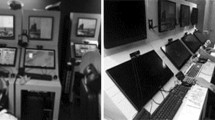Abstract
This article investigates the relationship between the control situation framework, as presented by Bjørkli et al. (Cogn Technol Work 9:67–80, 2007), and observed operator action and communication in high-speed craft operation in the Norwegian Royal Navy. The reported data include two series of events during sailing in the Norwegian archipelago where uncertainty of ship position, challenges of manoeuvring and navigation strategies are addressed. The results indicate that the navigators perform actions and communicate in accordance with the key features of the control situation framework, and thus adapt to the interrelation between control possibilities and control requirements. The navigators were guided by explicit knowledge of the functional characteristics of psychical and temporal dynamics, which were actualized in manoeuvring. It indicates that the control situation framework can be used to describe the models the operators use.




Similar content being viewed by others
Notes
Geographical direction of movement is denoted by a three-digit number between 000 and 359 where 000 reflects true north. The numbers increases clockwise, so a straight eastward movement is a 090 course, a southbound movement is 180, and a straight westward course is 270. The course 059 reflects a northeast movement.
Marine navigation within the archipelago depends on the use of landmarks and other navigational aids, such as beacons and iron perches that are placed to mark where it is possible to sail. Only lighted landmarks are used when sailing in darkness.
SHV indicates the Norwegian Maritime Civil Guard.
Obs indicates observation room, a room below deck that, among others, contains advanced surveillance equipment.
Maximal rudder angle means that there is an upper limit to the amount of rudder angle that will lead to an increase in turn rate. If one increases the turn rate beyond the maximum, the vessel’s turn rate will not increase. Instead, the vessel will begin to shake violently, as the increased energy output from the rudder’s deflection of water is transformed. The navigators try not to exceed the maximal turn rate as this can damage the ship.
The Norwegian term, “varme tørnet”, directly translated means “heating the turn”, indicating that one prepares the system to act in a given manner, which will not require any additional time lag or additional actions on the side of the navigator.
Abbreviations
- HSC:
-
High-speed crafts
- CO:
-
Commanding officer
References
Andersen PB (2000) Communication and work on maritime bridges. Research report CHMI-1–2000. Center for human–machine interaction. Aalborg University, Aalborg
Bernstein N (1967) The coordination and regulation of movements. Pergamon Press, London
Bjørkli CA, Øvergård KI, Røed BK, Hoff T (2007) Control situations in high-speed craft operation. Cogn Technol Work 9:67–80
Burns CM, Hajdukiewicz JR (2004) Ecological interface design. CRC, Boca Raton
Cacciabue PC (1996) Understanding and modelling man–machine interaction. Nucl Eng Des 165:351–358
Conant RC (1969) The information transfer required in regulatory processes. IEEE Trans Syst Sci Cybern SSC 5(4):334–338
Hollnagel E (1993) Requirements for dynamic modelling of man–machine interaction. Nucl Eng Des 144:375–384
Hollnagel E (2002) Time and time again. Theor Issues Ergon Sci 3(2):143–158
Hollnagel E (2005) Human reliability assessment in context. Nucl Eng Technol 37(2):33–40
Hollnagel E, Woods DD (2005) Joint cognitive systems: foundations of cognitive systems engineering. CRC, Boca Raton
Hutchins E (1995) Cognition in the wild. MIT Press, Cambridge
Kirwan B, Ainsworth LK (1992) A guide to task analysis. Taylor and Francis, London
Norros L (2004) Acting under uncertainty: the core-task analysis in ecological study of work. VTT Publications 546, Espoo
Øi Ø (1985) Håndbok i kyst og innenskjærs navigering. Sjøkrigsskolen, Bergen
Øvergård KI (2008) Human co-agency with technical systems: investigations of modelling frameworks. Doctoral thesis at NTNU 2008:281. Department of Psychology, Norwegian University of Science and Technology, Trondheim
Øvergård KI, Hoff T et al (2005) Control of human–technology processes: the bodily basis for control. In: Veiersted B (ed) Ergonomics as a tool in future development and value creation. Nordic Ergonomics Society, Oslo, pp 175–179
Petersen J (2002) Modelling control situations for the design of context sensitive human–machine systems. In: Johnson CW (ed) Human decision making and control. Department of Computing Science, University of Glasgow, Glasgow, pp 153–161. Available at http://www.dcs.gla.ac.uk/~johnson/eam2002/EAM_2002.pdf [downloaded 2007-12-13]
Petersen J (2004) Control situations in supervisory control. Cogn Technol Work 6:266–274
Petersen J, Nielsen M (2001) Analyzing maritime work domains. In Onken R (ed) Proceedings of the 8th conference on cognitive science approaches to process control. Universität der Bundeswehr, Neubiberg, pp 221–230
Rasmussen J (1990) The role of error in organizing behavior. Ergonomics 33(10/11):1185–1199
Røed BK (2007) Designing for high-speed ships. Doctoral thesis at NTNU 2007:115. Department of Product Design, Norwegian University of Science and Technology, Trondheim
Sarter NB, Woods DD (1995) How in the world did we ever get into that mode? Mode error and awareness in supervisory control. Hum Factors 37(1):5–19
Sarter NB, Woods DD (1997) Team play with a powerful and independent agent: operational experiences and automation surprises on the Airbus A-320. Hum Factors 39(4):553–569
Shaw RE, Flascher OM, Kadar EE (1995) Dimensionless invariants for intentional systems: measuring the fit of vehicular activities to environmental layout. In: Flach J (ed) Global perspectives on the ecology of human–machine systems. Lawrence Erlbaum, Mahwah, pp 293–345
Vicente K (1999) Cognitive work analysis: towards safe, productive, and healthy computer-based work. Lawrence Erlbaum, Mahwah
von Wright GH (1971) Explanation and understanding. Cornell University Press, London
Woods DD, Hollnagel E (2006) Joint cognitive systems: patterns in cognitive systems engineering. CRC, Boca Raton
Acknowledgement
The authors have no financial or otherwise conflicting interests in relation to any parts of this paper.
Author information
Authors and Affiliations
Corresponding authors
Rights and permissions
About this article
Cite this article
Øvergård, K.I., Bjørkli, C.A., Røed, B.K. et al. Control strategies used by experienced marine navigators: observation of verbal conversations during navigation training. Cogn Tech Work 12, 163–179 (2010). https://doi.org/10.1007/s10111-009-0132-9
Received:
Accepted:
Published:
Issue Date:
DOI: https://doi.org/10.1007/s10111-009-0132-9




